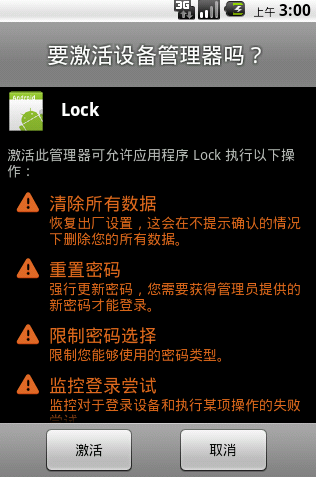
- Android蓝牙通信编程
- android如何添加桌面图标和卸载程序后自动删除图标
- android编程实现悬浮窗体的方法
- android编程之多线程编程实例分析
- android 对话框弹出位置和透明度的设置具体实现方法
- Android获取和读取短信验证码的实现方法
- Android自定义View实现折线图效果
- Android自定义格式显示Button的布局思路
- Android实现View滑动的几种方式
- [Android开发视频教学]01_05_Activity和Intent
- android中暂停背景音乐
- 在当前Activity之上创建悬浮view之WindowManager悬浮窗效果
- 解析Android中实现滑动翻页之ViewFlipper的使用详解
- Android中让按钮拥有返回键功能的方法及重写返回键功能
- Android中使用Service实现后台发送邮件功能实例
- Android编程获取sdcard音乐文件的方法
- Android判断设备网络连接状态及判断连接方式的方法
- Android编程中activity的完整生命周期实例详解
- android开发教程之handle实现多线程和异步处理
- RecyclerView的使用之HelloWorld
- Android实现广告图片轮播效果
- Android 清除SharedPreferences 产生的数据(实例代码)
- Android Handler之消息循环的深入解析
- 基于Android 实现图片平移、缩放、旋转同时进行
- 解析Android中webview和js之间的交互
- Android 实现电话来去自动录音的功能
- Android中TimePicker与DatePicker时间日期选择组件的使用实例
- Android listview多视图嵌套多视图
- Android使用OKHttp包处理HTTP相关操作的基本用法讲解
- Android数据类型之间相互转换系统介绍
Android编程获取系统隐藏服务实现锁屏的方法
作者:佚名 Android开发编辑:admin 更新时间:2022-07-23
本文实例讲述了Android编程获取系统隐藏服务实现锁屏的方法。分享给大家供大家参考,具体如下:
实现原理:当按锁屏键时,会发出一个广播,当界面接收到一个广播就可以实现锁频。我们可以调用IDevicePolicyManager服务中的lockNow方法来发送一个广播实现锁屏。
IDevicePolicyManager是被系统隐藏掉的,需要通过反射还获取此服务。
步骤:
1.创建MyAdmin的广播接收者继承DeviceAdminReceiver
2.通过反射 ,获取IDevicePolicyManager服务 ,IDevicePolicyManager通过AIDL来获取出来。
3.注册广播接收者为admin设备
4.获取服务中的方法
效果图:



注册MyAdmin广播接收者:
<receiver android:name=".MyAdmin">
<meta-data android:name="android.app.device_admin"
android:resource="@xml/my_admin" />
<intent-filter>
<action android:name="android.app.action.DEVICE_ADMIN_ENABLED" />
</intent-filter>
</receiver>
my_admin.xml:
<?xml version="1.0" encoding="utf-8"?>
<device-admin xmlns:android="http://schemas.android.com/apk/res/android">
<uses-policies>
<limit-password />
<watch-login />
<reset-password />
<force-lock />
<wipe-data />
</uses-policies>
</device-admin>
反射获取服务、注册权限、实现锁屏:
public class LockActivity extends Activity {
IDevicePolicyManager mService;
@Override
public void onCreate(Bundle savedInstanceState) {
super.onCreate(savedInstanceState);
setContentView(R.layout.main);
}
//锁屏
public void lock(View view){
try {
//通过反射获取到sdk隐藏的服务
Method method = Class.forName("android.os.ServiceManager")
.getMethod("getService", String.class);
IBinder binder = (IBinder) method.invoke(null,//激活服务
new Object[] { Context.DEVICE_POLICY_SERVICE });
mService = IDevicePolicyManager.Stub.asInterface(binder);
//定义组件的名字
ComponentName mAdminName = new ComponentName(this, MyAdmin.class);
//注册权限
if (mService != null) {
//判断自定义的广播接受者 是不是被注册成 deviceadmin的权限
if (!mService.isAdminActive(mAdminName)) {
Intent intent = new Intent(
DevicePolicyManager.ACTION_ADD_DEVICE_ADMIN);
intent.putExtra(DevicePolicyManager.EXTRA_DEVICE_ADMIN,
mAdminName);
startActivity(intent);
}
//调用服务实现锁屏
mService.lockNow();
//设置解锁密码
mService.resetPassword("123", 0);
}
} catch (Exception e) {
e.printStackTrace();
}
}
}
AIDL:
/*
**
** Copyright 2010, The Android Open Source Project
**
** Licensed under the Apache License, Version 2.0 (the "License");
** you may not use this file except in compliance with the License.
** You may obtain a copy of the License at
**
** http://www.apache.org/licenses/LICENSE-2.0
**
** Unless required by applicable law or agreed to in writing, software
** distributed under the License is distributed on an "AS IS" BASIS,
** WITHOUT WARRANTIES OR CONDITIONS OF ANY KIND, either express or implied.
** See the License for the specific language governing permissions and
** limitations under the License.
*/
package android.app.admin;
import android.content.ComponentName;
/**
* Internal IPC interface to the device policy service.
* {@hide}
*/
interface IDevicePolicyManager {
void setPasswordQuality(in ComponentName who, int quality);
int getPasswordQuality(in ComponentName who);
void setPasswordMinimumLength(in ComponentName who, int length);
int getPasswordMinimumLength(in ComponentName who);
boolean isActivePasswordSufficient();
int getCurrentFailedPasswordAttempts();
void setMaximumFailedPasswordsForWipe(in ComponentName admin, int num);
int getMaximumFailedPasswordsForWipe(in ComponentName admin);
boolean resetPassword(String password, int flags);
void setMaximumTimeToLock(in ComponentName who, long timeMs);
long getMaximumTimeToLock(in ComponentName who);
void lockNow();
void wipeData(int flags);
void setActiveAdmin(in ComponentName policyReceiver);
boolean isAdminActive(in ComponentName policyReceiver);
List<ComponentName> getActiveAdmins();
boolean packageHasActiveAdmins(String packageName);
void removeActiveAdmin(in ComponentName policyReceiver);
void setActivePasswordState(int quality, int length);
void reportFailedPasswordAttempt();
void reportSuccessfulPasswordAttempt();
}
希望本文所述对大家Android程序设计有所帮助。
- android获取手机IMSI码判断手机运营商代码实
- android异步请求服务器数据示例
- 基于Android 监听ContentProvider 中数据变
- Android之用PopupWindow实现弹出菜单的方法
- Android常用命令集锦(图文并茂适应于初学者
- Android图片上传实现预览效果
- [Android开发视频教学]01_29_代码编写(一)